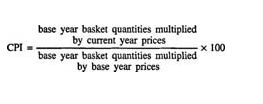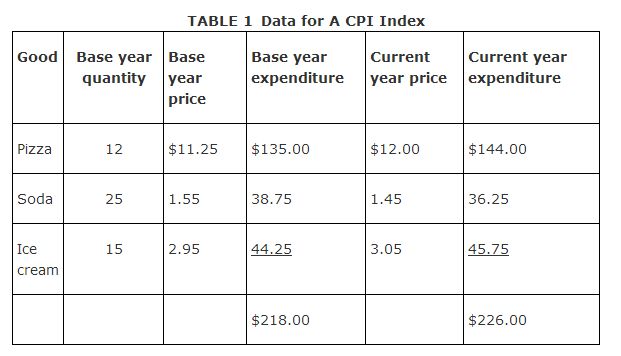Nominal GDP, Real GDP, and Price Level
Nominal GDP is GDP evaluated at current market prices. Therefore, nominal GDP will include all of the changes in market prices that have occurred during the current year due to inflation or deflation. Inflation is defined as a rise in the overall price level, and deflation is defined as a fall in the overall price level. In order to abstract from changes in the overall price level, another measure of GDP called real GDP is often used. Real GDP is GDP evaluated at the market prices of some base year. For example, if 1990 were chosen as the base year, then real GDP for 1995 is calculated by taking the quantities of all goods and services purchased in 1995 and multiplying them by their 1990 prices.
GDP deflator. Using the statistics on real GDP and nominal GDP, one can calculate an implicit index of the price level for the year. This index is called the GDP deflator and is given by the formula

![]()
The GDP deflator can be viewed as a conversion factor that transforms real GDP into nominal GDP. Note that in the base year, real GDP is by definition equal to nominal GDP so that the GDP deflator in the base year is always equal to 100.
Calculating the rate of inflation or deflation. Suppose that in the year following the base year, the GDP deflator is equal to 110. The percentage change in the GDP deflator from the previous (base) year is obtained using the same formula used to calculate the growth rate of GDP. This percentage change is found to be

![]()
implying that the GDP deflator index has increased 10%. Another way of describing this finding would be to say that the inflation rate in the year following the base year was 10%. More generally, if the percentage change in the GDP deflator over some period is a positive X%, then the rate of inflation over the same period is X%. If the percentage change in the GDP deflator over some period is a negative X%, then the rate of deflation over that period is X%.
Consumer price index. The GDP deflator is not the only index measure of the price level. Among the many other price indices, the consumer price index (CPI) is the most frequently cited. The CPI differs from the GDP deflator in two important ways. First, the CPI measures only the change in the prices of a “basket” of goods consumed by a typical household. Second, the CPI uses base year quantities rather than current year quantities in calculating the price level index value. The formula for the CPI is given as ![]()

Construction of a price index. As an example of a CPI index, assume for the sake of simplicity that the basket of goods consumed by a typical household consisted of just three goods: pizza, soda, and ice cream. The quantities consumed of each of these three goods in the base year are given in Table , along with the prices of these three goods in both the base year and the current year.

The base year expenditure figures are found by multiplying the base year quantities by the base year prices. Similarly, the current year expenditure figures are found by multiplying the base year quantities by the current year prices. In order to calculate a CPI for this basket of three goods, one needs only the total base year and current year expenditures on all three goods. The CPI value for the current year may then be calculated as follows:

![]()
The CPI value for the base year is always equal to 100. In this case,

![]()
![]()
Thus, the percentage change in the current year CPI from the base year CPI is
![]()

![]()
![]()

![]()
![]()
![]()
In other, words, the rate of inflation in the current year is 3.67%
![]()
![]()